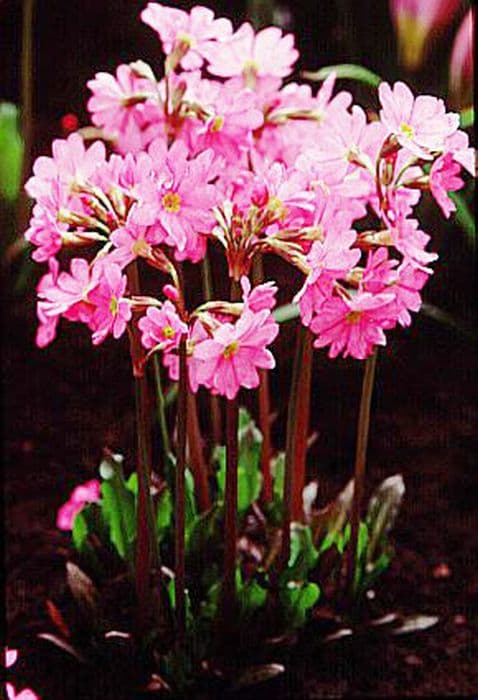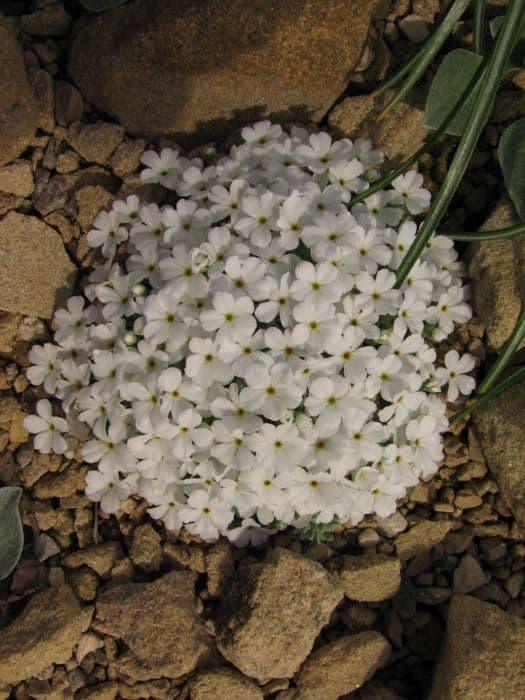Himalayan Meadow Primrose Primula rosea (Or)

ABOUT
The Himalayan meadow primrose is a charming flowering plant with vibrant pink flowers that have a yellow eye at the center. These blooms are arranged in clusters atop the green, oval-shaped leaves that form a lush rosette at the plant's base. The leaves have a sort of crinkled texture, which adds to the plant's visual interest. The flowers emerge on stems that rise above the foliage, creating a delightful contrast against the green backdrop. The profusion of bright blossoms makes it an eye-catching addition to any garden space where it is grown. The overall appearance of the Himalayan meadow primrose is one that exudes a wild, natural beauty, often reminiscent of the alpine meadows where such plants are typically found.
About this plant
 Names
NamesFamily
Primulaceae.
Synonyms
Rosy Primrose, Himalayan Meadow Primrose, Pink Primula.
Common names
Primula rosea.
 Toxicity
ToxicityTo humans
Primrose is generally considered a non-toxic plant to humans, and there is limited information on its toxicity. However, all parts of the plant may contain small amounts of saponins and other compounds which can sometimes cause mild stomach upset if ingested in significant quantities. It is not known for causing serious health issues in humans, but as with any plant, individual reactions can vary, and it is advisable to avoid ingesting this or any ornamental plant.
To pets
Primrose is not known to be highly toxic to pets, but it might cause mild gastrointestinal upset, such as vomiting or diarrhea, if ingested in large amounts. As with humans, the presence of saponins and other compounds in the plant may act as irritants. It is recommended to keep pets from eating ornamental plants as they could have various reactions depending on the individual animal's sensitivity.
 Characteristics
CharacteristicsLife cycle
Perennials
Foliage type
Deciduous
Color of leaves
Green
Flower color
Pink
Height
6 inches (15 cm)
Spread
8 inches (20 cm)
Plant type
Herb
Hardiness zones
5
Native area
Himalayas
Benefits
 General Benefits
General Benefits- Ornamental Value: The rosy primrose is prized for its bright pink blossoms that add color and beauty to gardens and landscapes.
- Attracts Pollinators: The flowers of the rosy primrose attract bees, butterflies and other beneficial pollinators, supporting biodiversity.
- Easy Maintenance: As a hardy plant, it requires minimal care once established, making it suitable for novice gardeners.
- Seasonal Interest: It blooms in the early spring, providing early-season interest in the garden when other plants are not yet in flower.
- Compact Growth: Its small and compact size makes it ideal for rock gardens, containers, or small garden spaces.
- Herbaceous Perennial: As a perennial, it returns year after year, offering long-term enjoyment without the need to replant annually.
- Moisture Indicator: It prefers moist conditions; thus, its presence can indicate areas in the landscape with adequate water or indicate when additional watering is needed.
 Medical Properties
Medical Properties- Anti-inflammatory: Primula rosea has been used in traditional medicine to reduce inflammation.
- Antispasmodic: It may also have properties that help relieve spasms.
- Diuretic: There are claims that this plant can act as a diuretic, aiding in the removal of excess water from the body.
 Air-purifying Qualities
Air-purifying QualitiesThis plant is not specifically known for air purifying qualities.
 Other Uses
Other Uses- Adding color to salads: The bright pink flowers of the Primula rosea can be used as an edible garnish to add a pop of color and a mild, sweet flavor to green salads.
- Natural dye: The petals of the Primula rosea can be boiled to extract a natural dye that can be used for coloring fabrics or even Easter eggs.
- Garden aesthetics: With their vibrant colors, they can be planted in rock gardens, borders, or as a ground cover to enhance the visual appeal of the area.
- Companion planting: Primula rosea can be grown alongside other moisture-loving plants to create a cohesive and supportive planting environment.
- Butterfly attraction: The flowers attract butterflies and other pollinators, which can help pollinate other plants in the garden.
- Educational tool: Primula rosea can be used in schools or educational programs to teach students about plant biology, life cycles, and horticulture.
- Culinary experimentation: Some chefs may use the flowers to experiment with new dessert presentations, flavorings, or as part of an herbal infusion for drinks.
- Photography subject: The striking colors and textures of Primula rosea make it a popular subject for photographers, especially in macro photography.
- Floral arrangements: Fresh or dried Primula rosea flowers can be used in floral arrangements to provide a touch of nature indoors.
- Art inspiration: Artists may use the distinct look of Primula rosea as inspiration for paintings, drawings, and other art forms.
Interesting Facts
 Feng Shui
Feng ShuiThe Primrose is not used in Feng Shui practice.
 Zodiac Sign Compitability
Zodiac Sign CompitabilityThe Primrose is not used in astrology practice.
 Plant Symbolism
Plant Symbolism- Youthfulness: Primula, commonly known as primrose, often symbolizes the essence of youth and vitality because they are among the first flowers to bloom in spring.
- Renewal: As a herald of spring, primroses symbolize new beginnings, rebirth, and the rejuvenation of nature after winter.
- Love and Affection: With its delicate and cheerful appearance, the primrose can represent the blossoming of love and the care one person holds for another.
- Hope: The primrose's penchant for blooming in early spring also makes it a representation of hope and the expectation of better times ahead after the cold winter months.
- Protection: According to some traditions, primroses have been thought to provide protection against evils and misfortune, especially when planted at the doorstep.
 Water
WaterHimalayan meadow primrose should be watered moderately, ensuring the soil stays moist but not waterlogged. During the growing season, typically in spring and summer, water the plant generously about once a week with about one gallon per square foot of soil, adjusting based on rainfall and temperature. Reduce watering frequency in the fall and winter to prevent root rot. Always check the top inch of soil for dryness before watering to avoid overwatering, which can be harmful to the plant's health.
 Light
LightHimalayan meadow primrose thrives in partial shade where it can receive bright, indirect sunlight. The ideal spot for this plant is one where it's shielded from the intense midday sun, such as under a tree canopy or beside a structure that casts partial shadow. Avoid exposing it to prolonged hours of direct sunlight, especially in hotter climates, to prevent scorching the leaves.
 Temperature
TemperatureThe Himalayan meadow primrose prefers cool to moderate temperatures, flourishing in a range between 50°F and 70°F. It can tolerate minimum temperatures down to around 32°F, but frost can cause damage, and maximum temperatures should not exceed 80°F to prevent heat stress. The ideal temperature conditions are within the cool to mild range, which will support healthy growth and flowering.
 Pruning
PruningPruning Himalayan meadow primrose is primarily for removing spent flowers and dead or damaged foliage to encourage new growth and additional blooming. Light pruning can be done throughout the blooming season as needed. The best time for more extensive pruning is immediately after flowering has finished in late spring or early summer.
 Cleaning
CleaningAs needed
 Soil
SoilRosy Primrose thrives in consistently moist, well-draining soil enriched with organic matter, such as peat or leaf mold. Ideal soil pH for Rosy Primrose should be between 6.0 and 7.5. For best results, a mix of loam, peat, and perlite in equal parts can be used to maintain the necessary moisture and drainage balance.
 Repotting
RepottingRosy Primrose typically needs to be repotted every one to two years, preferably in the spring. Inspect the root system; if the roots have filled the pot, it's time to repot into a slightly larger container maintaining the same soil composition.
 Humidity & Misting
Humidity & MistingRosy Primrose prefers high humidity conditions to thrive. Aim for a humidity level of 50% or higher. They are more likely to prosper outdoors in a naturally humid environment, but indoor growers should consider using a humidifier or pebble tray to raise moisture around the plant.
 Suitable locations
Suitable locationsIndoor
Place Rosy Primrose near bright, indirect light and maintain high humidity.
Outdoor
Place in partial shade, ensure moist soil and protect from midday sun.
Hardiness zone
5-7 USDA
 Life cycle
Life cyclePrimula rosea, commonly known as Rosy Primrose, begins its life cycle as a seed, typically sown in cold conditions as it requires a period of cold stratification to germinate. Upon exposure to favorable temperatures in spring, the seed germinates and develops into a small rosette of leaves close to the ground. As the plant matures, it forms a more substantial leaf rosette, and a flowering stalk emerges, bearing clusters of bright pink to rosy-purple flowers. After pollination, often by insects attracted to the flowers' color and nectar, the flowers develop into capsules containing numerous tiny seeds. These seeds are then dispersed by various means, including wind and water, completing the reproductive cycle. In its perennial phase, the Rosy Primrose will enter a period of dormancy during the winter, conserving energy to begin the cycle anew come spring.
 Propogation
PropogationPropogation time
Spring-Summer
The Himalayan Meadow Primrose, known scientifically as Primula rosea, can be propagated most popularly by seed. The best time to sow seeds is late winter to early spring. To propagate by seed, surface sow the tiny seeds on a well-draining seed-starting mix, as light aids germination. It's essential to not cover the seeds with soil but to press them gently into the surface. Maintain moisture but avoid overwatering to prevent fungus or seed rot. Top the container with clear plastic wrap or a propagation dome to maintain humidity, placing it in a location with bright, indirect light and a temperature around 60 to 65 degrees Fahrenheit (15.5 to 18.3 degrees Celsius). Seedlings will typically emerge within 3 to 6 weeks and can be transplanted into individual pots once they have several true leaves.








![Primrose [Belarina Amethyst Ice]](/_next/image?url=https%3A%2F%2Fplants-admin.emdemapps.com%2Fimages%2Fplants%2F%2Fimages%2F604b59c727782.png&w=640&q=75)
